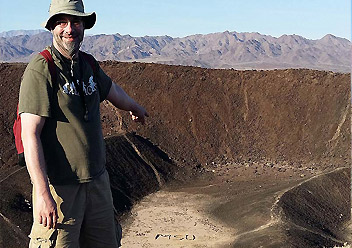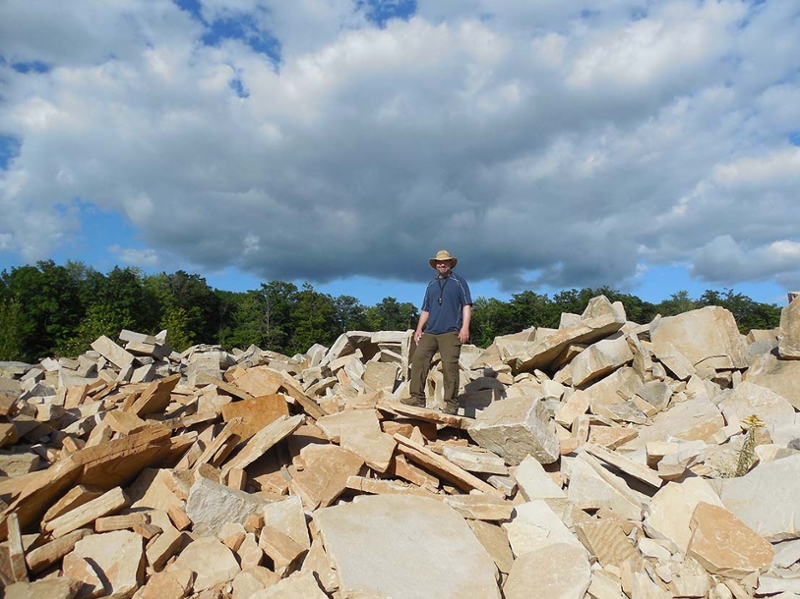
Associate Professor
Office: Office 119 CMSC
Email: joseph.collette@minotstateu.edu
Standing on the rim of an extinct cinder cone in Amboy, CA
Courses Taught:
Geology 105 - Physical Geology
Geology 106 - Historical Geology
Geology 300 - Geologic Field Methods
Geology 323 - Global Climate Change
Geology 311 - Paleontology
Geology 471 - Stratigraphy and Sedimentation
Geology 499 - Special Topics (Geomorphology)
Science 240 - Research Methods
Science 505 - Biogeochemical Cycles (Graduate-level, co-taught with Dr. Crackel)
Research Interests:
I'm interested in questions that address issues in the early evolution of arthropods and their cryptic movement toward land during Cambrian time. In the very low-gradient, high-energy, nearshore environments in which this transition is posited to have occurred, conditions were such that the animals themselves are only exceedingly rarely preserved. Indeed, it may have been the extreme difficulty of living in these environments that preadapted these animals to make the very first landfall during the Cambrian some 510 million years ago. Even with this dearth of body fossils, we can still explore some of these issues by looking at the abundant and well-preserved traces left by the animals as they crawled across the ancient seafloor. These trace fossils fascinate me, not only because they show the interaction of animals with the substrate and the environment, but because they are our only means of assessing the behavior of fully extinct animals at a critical transitional period in time.

Slab surfing 510 million-year-old sandstone somewhere in central Wisconsin.
I am interested in working with students on these, and on a variety of other paleontological topics ranging from systematics and evolution to trace fossils and geometric morphometrics. One of the things that I love most about specimen-based paleontology is that it is a truly multi-disciplinary field-based science that bridges the gaps between biology, geology, and many other disciplines. Fieldwork is, therefore, a fundamental part of what I do, and there will be ample opportunity for student involvement in multi-week long summer research trips to both nearby and further afield localities. If you are interested in what these research opportunities might be, please send me an email. Or perhaps even better, drop by my office for a cup of coffee and a chat.
Current Student Research Group:
Tessa Cammel, undergraduate researcher. Working on describing, naming, and biostratigraphy of a brand new late Cambrian saukiid trilobite species from the Sawback mountains in the Canadian Rockies of Alberta.
Ana Swor, undergraduate researcher. Working on quantifying the continental gradient in a difficult, nearshore, intertidal, epicontinental sand-dominated paleoenvironment that may have produced the very first animals to crawl ashore during the Cambrian, some 500 million years ago. Ana's research page can be found here.
Calob Werre, undergraduate researcher. Working on a geometric morphometric study seeking to quantify the intra- and interspecific variation that may be confounding the systematics of several genera of Cambrian-age saukiid trilobites from Laurentia.
Emily Schaefer, graduate student researcher. Working on a large surface of 500 million year-old stranded jellies that occur on an intensely bioturbated sandy surface. Emily is interested to know if the jellies may have been a food resource that was being actively seeked out by the animals inhaditing this nearshore environement, or if the animals present were eating something else entirely.
Krzysztof Broda, Ph.D. candidate - University of Silesia, Będzińska, Sosnowiec, Poland (I am an external member). Krzysztoff is working on describing some new phyllocarid crustaceans from the Upper Devonian of Kowala quarry which is located in the Holy Cross Mountains of central Poland.
Education:
2014 Ph.D. in Geosciences. University of California, Riverside.
2009 M.S. in Geology. University of Massachusetts, Amherst.
Thesis: Exceptionally Preserved Cambrian Arthropods from Quebec and Wisconsin.
2007 B.S. in Geology. University of Massachusetts, Amherst.
Honors Thesis: An Early Jurassic Non-Marine Trace Fossil Assemblage from the Portland Formation, Hartford Basin, Massachusetts.
Recent Publications (pdf available on request):
Collette, J.H., Isbell, J.L. and Miller, M.F. In Review, Journal of Paleontology. A unique winged euthycarcinoid from the late Paleozoic of Antarctica. Journal of Paleontology, 19 manuscript pages.
Collette, J.H., Gass, K.C. and Hagadorn, J.W. 2012. Protichnites eremita unshelled? Experimental model-based neoichnology and new evidence for a euthycarcinoid affinity for this ichnospecies. Journal of Paleontology, 86(3): 442–454.
Collette, J.H., Getty, P.R. and Hagadorn, J.W. 2011. An Early Jurassic Non-Marine Trace Fossil Assemblage from the Portland Formation, Hartford Basin, Massachusetts. Atlantic Geology, 47, 81–98.
Hagadorn, J.W., Collette, J.H. and Belt, E.S. 2011. Eolian-aquatic deposits and faunas of the middle Cambrian Potsdam Group. Palaios, 26(5):314-334.
Collette, J.H., Hughes, N.C. and Peng, S.-C. 2011. The first report of a Himalayan bradoriid arthropod and the paleogeographic significance of this form. Journal of Paleontology, 85:76–82.
Collette, J.H. and Rudkin, D.M. 2010. Phyllocarid crustaceans from the Silurian Eramosa Lagerstatte (Ontario, Canada): Taxonomy and functional morphology. Journal of Paleontology, 84:118–127.
Collette, J.H. and Hagadorn, J.W. 2010. Three-dimensionally preserved arthropods from Cambrian Lagerstätten of Quebec and Wisconsin. Journal of Paleontology, 84:646–667.
Collette, J.H. and Hagadorn, J.W. 2010. Early evolution of phyllocarid arthropods: Phylogeny and systematic of Cambrian-Devonian Archaeostracans. Journal of Paleontology, 84:795–820.
Collette, J.H., Hagadorn, J.W. and Lacelle, M.A. 2010. Dead in their tracks: Cambrian arthropods and their traces from intertidal sandstones of Quebec and Wisconsin. Palaios, 25:475–486.
Budil, P., Collette, J.H., and Manda, S. 2010. An unusual occurrence of Ceratiocaris papilio Salter in the lower Ludfordian (Silurian) of Bohemia (peri-Gondwana). Bulletin of Geosciences, 85(4):551–564.




